Birds of Florida
Shorebirds
On this page - Brown Pelican, Willet, Spotted Sandpiper, Sanderling, Ruddy Turnstone, Killdeer, Black-bellied Plover, Lesser Yellow-legs, Black-necked Stilt, Black Skimmer, Royal Tern, Laughing Gull, Ring-billed Gull
Brown Pelican - Pelecanus occidentalis
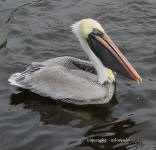
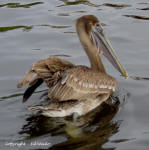
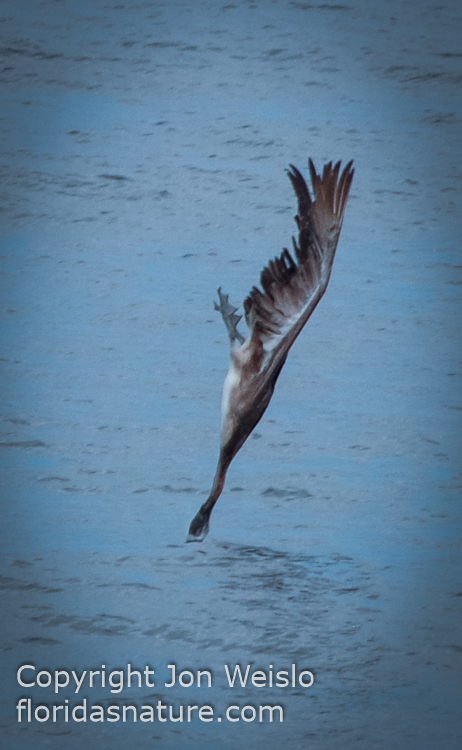
The Brown Pelican is one of the most easily recognizable water birds found in Florida, with its large bill and a featherless, expandable throat pouch able to hold up to three gallons of water, with fish included!
Pelicans have a body length of 4 feet and a seven foot plus wingspan, juveniles are brown with a white belly, adults are grayish-brown with yellow crown, neck is white in winter - chestnut brown in summer.
Feeding alone or in groups near shore in the ocean, bays and estuaries this is the only Pelican of the seven species found worldwide that dives from the air onto its prey. Scooping up its prey fish into its large pouch, the Pelican squeezes out the water before swallowing the fish whole.
Willet - Tringa semipalmata
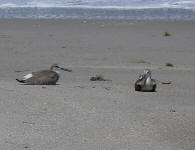
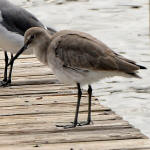
A larger member (to 15 inches) of the Sandpiper family, Willets are grey above and white below, when breeding they are speckled brownish grey above. In flight, striking black wings with a white center stripe are revealed. Legs are blue-grey, bill is long and straight.
Willets can be found in all coastal areas of Florida, generally in large groups feeding on small invertebrates at the shoreline or on mudflats. Willets nest on the ground in the grass of Salt marshes or in dune grasses above the high tide line, producing 3 to 5 olive to sky-blue eggs with brown speckles.
Spotted Sandpiper - Actitis macularia
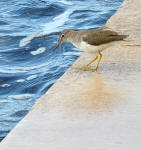
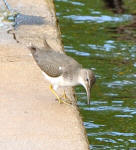
The Spotted Sandpiper at 8 inches is a smaller shorebird, also known as the "Teeter-tail" from the constant teetering of its rump. It is the most widespread sandpiper in North America.
Adult basic has dark bill with a lighter base, brown head with a darker eye line, pale supercilium (eyebrow), and is white on the throat, breast, underneath with yellow to pinkish legs. Alternate has dark spots on throat, breast and belly and dark bars on upper wings and back. Diet consists primarily of small aquatic invertebrates.
Sanderling - Calidris alba
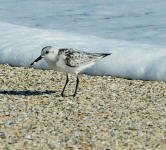
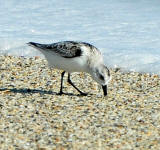
Sanderling begin arriving on Florida coasts in August and winter here through April, when they begin their migration northward to Artic breeding grounds.
At 8 inches Sanderling are a smaller shorebird often seen in groups of up to 20 birds. Running behind the receding waves they quickly probe the sand for the small crustaceans that make up the bulk of their diet, they then run ahead of the next wave, repeating this action over and over.
Ruddy Turnstone - Arenaria interpres
_small1.jpg)
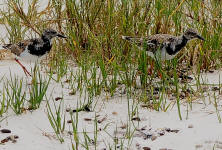
A small, stocky shorebird that gets its name from its characteristic flipping of stones, seaweed and other debris as it searches for small aquatic crustaceans and insects that make up the majority of its diet.
Body length is 6 - 8 inches with a wingspan of about 20 inches, the ruddy turnstone has short orange legs.
Wintering along the the coast of Florida, the Ruddy Turnstone is often seen in small groups of birds.
Killdeer - Charadrius vociferus
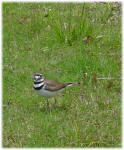
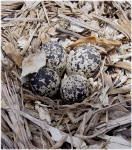
Adult Killdeer are about 10 inches long with two dark bands on the breast and another encircling the head. Upper portion of the body is grayish-brown, lower portion is white.
The Killdeer is a shorebird that more often then not is found away from the shore! Scurrying about in a darting, starting and stopping fashion, the Killdeer can be seen in grassy areas with little or no vegetation such as lawns, golf courses and even highway medians.
Killdeer nests are little more than slight scrapes on the ground, the parent birds are always nearby, ready to lead intruders away from its nest or babies.
Feigning a broken wing, they will let you get almost to them, then flap clumsily ahead, repeating this until they think they have lured you far enough away from the nest that you are no longer a danger to it or the babies, they then simply fly away.
Black-bellied Plover - Pluvialis squatarola, A.K.A. Grey Plover
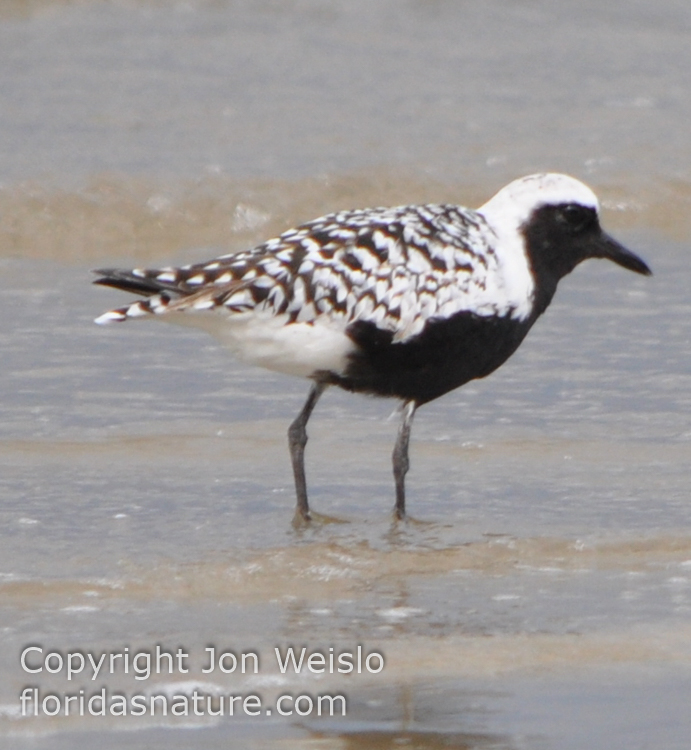
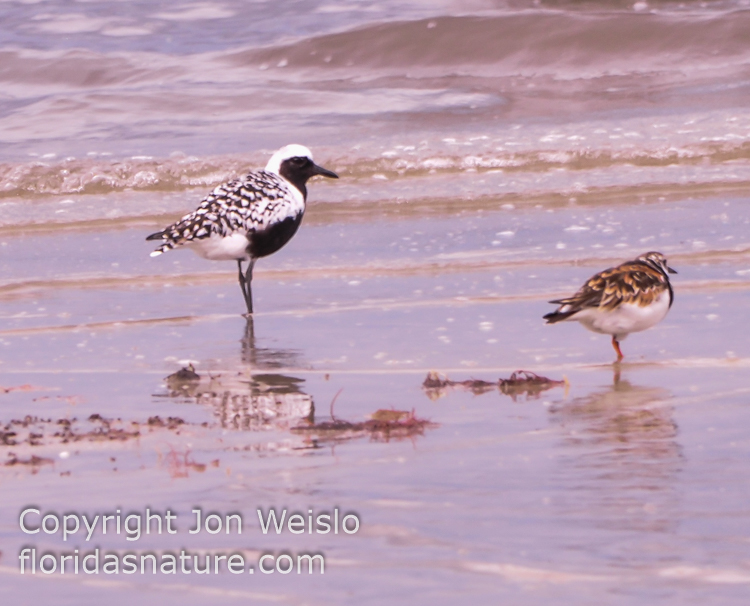
A medium to large stocky shorebird, 11-12 inches long with a 28-33 inch wingspan, moderately long legs, the largest plover in North America. Striking breeding plumage with black chest and belly, a white rump and crown that extends down the sides of the neck. Crown is grey speckled on top of the rounded head
Habitat - (Florida) - Mudflats, open marshes, mostly on open sand beaches, tidal flats. Breeds in the Arctic regions in open tundra habitat, winters on the coast of North America southward from Massachusetts to the West Indies.
Diet consists of insects, small crustaceans and marine worms.
Lesser Yellow-legs - Tringa flavipes
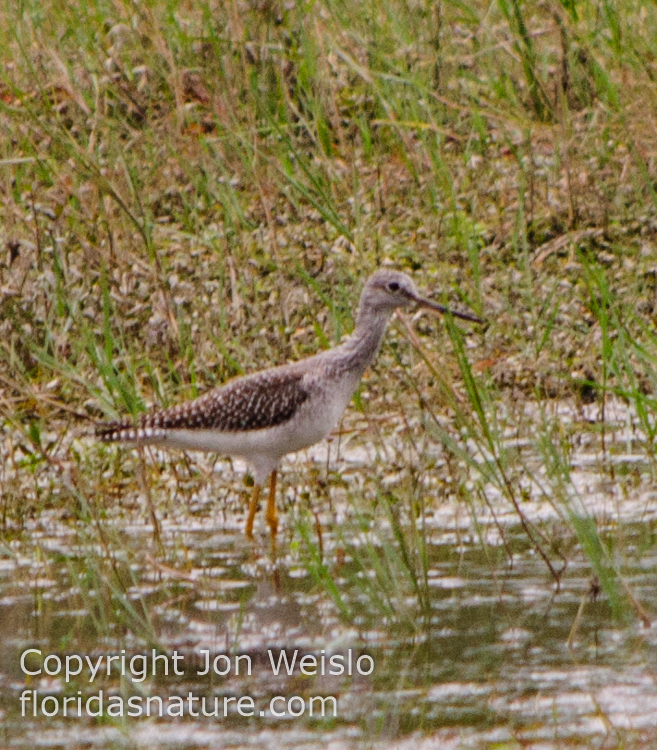
A medium-sized shorebird, the Lesser yellow-legs has its namesake long yellow legs with a thin pointed bil bill just longer than its head, white underside, pale gray above with white markings. Breeding adult is speckled above white eye ring.
Habitat - Common in Florida during winter. Marshes, mudflats, tidal flats. During migration, coastal estuaries, salt and fresh marshes, edges of freshwater lakes and ponds.
Typically feeds in very shallow waters. Diet consists of aquatic and terrestrial insects, crustaceans, small fish that it will actively chase and catch.
Black-necked Stilt - Himantopus mexicanus
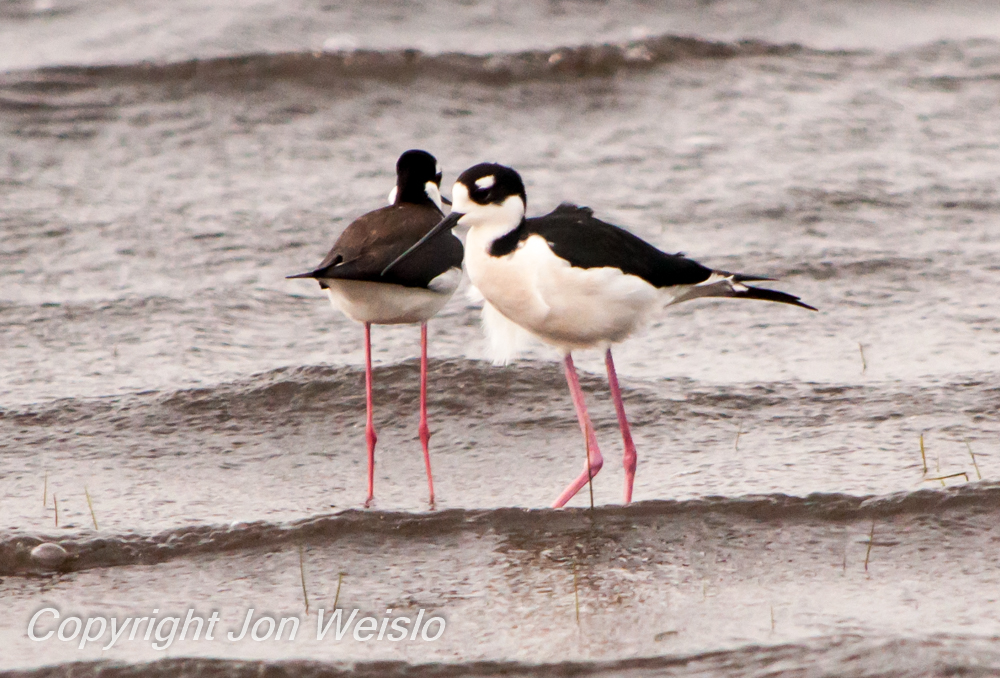
Range includes all of Florida. Black-necked Stilts wade for their food in shallow open water and on mudflats of both fresh and salt water wetlands without much - vegetation around. Diet includes insects such as beetles, water boatmen, brine flies, as well as crustations, tadpoles and small fish.
Black-necked stilts stay close together when foriging or roosting and will defend nesting sites as a group.
Nests are made on the ground slightly above water level, nests are a shallow scrape about 2 inches deep, it may or may not be lined with whatever bits of stone, grass or any nearby material. 1 - 5 brown speckled, olive green eggs, One brood per year.
Royal Tern - Thalasseus maximus
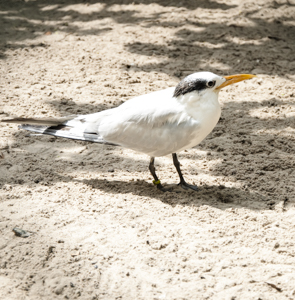
The royal tern is one of the largest terns in North or South America, surpassed only by the caspian tern . Rarely sighted inland the royal tern is a bird of the coastal regions.
The royal tern has an orange-red bill, pale grey upper parts, all white under parts and black legs with an average adult wingspan of 51 inches.
Usually feeding in shallow waters, royal terns feed mainly on small surface schooling fish and shrimp they catch by diving on from 20-30 feet in the air, consuming their prey on the wing.
Nesting in large colonies royal terns dig a small depression in the sand with their feet before laying 1 or 2 whiteish to brown eggs with heavy spotting on the larger end. Chicks hatch with eyes open and are able to leave the nest within a day of hatching.
Laughing Gull - Leucophaeus atricilla
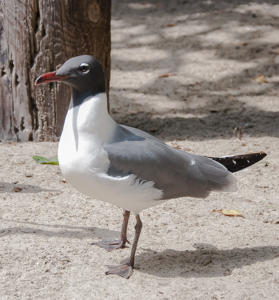
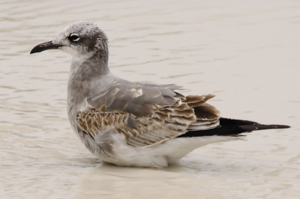
The laughing gull is a medium-sized gull named for its laugh-like call. Color is medium gray above and white below, breeding adults have a black head, white arcs around the eyes, and a red bill. Non-breeding adults have light grey on the neck, breast and a grey smudge mark on the head. Average adult wingspan is approximately 44 inches with a body length of 14 to 18 inches or about the size of a crow.
The Laughing Gull breeds along the Atlantic and Gulf Coasts of North America, the Caribbean, and Mexico's Pacific coast. Populations from coastal North Carolina northward migrate south to central America and northern South America Florida resident birds generally do not migrate.
An opportunistic omnivore and scavenger normally active during the day, in the breeding season it forages at night as well. Diet includes earthworms, insects, snails, crabs, and other invertibrates
Laughing Gulls form breeding colonies of up to 25,000 pairs, making their nests on sand, rocks, mats of dead vegetation, or hidden among the leaves of low plants. They typically look for slightly higher spots in order to minimize the chance of the nest being flooded by high tides or storm water.
Black Skimmer - Rynchops niger
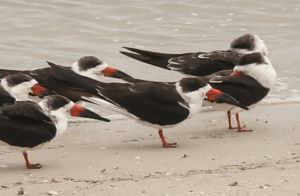
The Black Skimmer is a seabird in the gull family (Laridae) , the largest of three skimmer species.
Wingspan is 42 - 50 inches and the body is 16 - 20 inches long, females are slightly smaller. The basal half of the bill and legs are red and the lower mandible is noticably elongated, they fly low over the water with the long lower mandible skimming just the surface of the water, instantly snapping the bill shut when it feels a fish. Upper and lower mandibles of young are same length at first so they are able to pick up food dropped on the ground by parents.
Adults in breeding plumage have a black crown, nape and upper body. The forehead and underparts are white. The upper wings are black with white on the rear edge, and the tail and rump are dark grey with white edges. The underwing colour varies from white to dusky grey.
Non-breeding adults have paler and browner upperparts, and a white nape and collar. Immature birds have brown upperparts with white feather tips and fringes. The underparts and forehead are white.
Inhabits protected coastal waters such as lagoons, estuaries, often seen resting in groups on sheltered beaches and sand bars. Nest is a shallow scpape with 3 to as many as 7 buff to blue-ish eggs with dark blotches.
Ring-billed Gull - Larus delawarensis
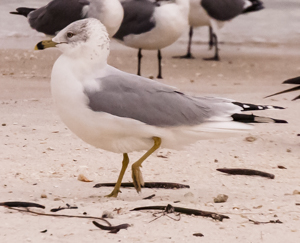
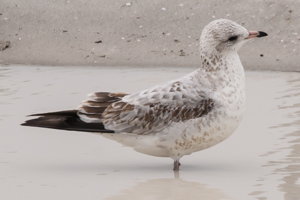
Adult Ring-billed gulls have a wingspan of 41 - 46 inches (105-117 cm), with a body length of 17 - 21 inches (43-54 cm). A very common, widespread gull in North America.
Coloration is gray above with a white head, body and tail, wingtips are black with white spots, yellow legs and bill with a black band around their bill.
Nonbreeding adults have brown-streaked heads.
Juvenile Ring-billed Gulls are a motley brown and gray with a pink bill and legs. These birds are opportunistic feeders and have adapted well to living around humans, congregating at garbage dumps, fast food parking lots, and freshly plowed fields. Although common on coastal beaches, many Ring-billed gulls lead inland lives, never visiting salt water.
Nest site is on the ground near water, in an area with sparse plant growth. Nest is a shallow depression lined with grasses, twigs and moss. Usually 2-4 eggs, gray to olive colored, with brown blotches.